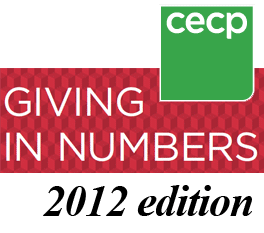 The Committee to Encourage Corporate Philanthropy and The Conference Board have released their 2011 corporate giving data report: “Giving In Numbers 2012 Edition.” Over 200 corporations participated in the survey, including 62 of the Fortune 100. The 54 page report provides a wealth of data focusing on trends in giving including cash giving, non-cash giving, volunteer programs, management and program costs, giving focus areas, and more. For the time-challenged reader, I’ve included a few highlights to consider as it relates to the cause partnerships piece of the corporate giving puzzle.
The Committee to Encourage Corporate Philanthropy and The Conference Board have released their 2011 corporate giving data report: “Giving In Numbers 2012 Edition.” Over 200 corporations participated in the survey, including 62 of the Fortune 100. The 54 page report provides a wealth of data focusing on trends in giving including cash giving, non-cash giving, volunteer programs, management and program costs, giving focus areas, and more. For the time-challenged reader, I’ve included a few highlights to consider as it relates to the cause partnerships piece of the corporate giving puzzle.
 As is true each year, health, education, and community and economic development were top priorities for companies in 2011. Also in 2011, the earthquake in Japan drove an increase in overall giving, resulting in both allocations directly from giving departments and targeted matching-gift campaigns.
As is true each year, health, education, and community and economic development were top priorities for companies in 2011. Also in 2011, the earthquake in Japan drove an increase in overall giving, resulting in both allocations directly from giving departments and targeted matching-gift campaigns.
CORPORATE GIVING IN THIS REPORT IS BROKEN DOWN INTO 3 CATEGORIES:
- Direct Cash: Cash giving from corporate headquarters or regional offices.
- Foundation Cash: Cash contributions from the corporate foundation. For many companies, this includes the corporate side of employee matching-gift programs.
- Non-Cash: Product donations, probono service, and other non-cash contributions (computers, land, etc.)assessed at Fair Market Value (FMV).
Non-cash giving dominates corporate contributions when viewed in aggregate, but this figure is influenced by substantial donations of medicines by the Pharmaceuticals industry. As a whole, in 2011 the typical company provided most of its giving in cash from corporate budgets and its corporate foundation.
 Motivations for all of the corporate giving in the CGS Survey provides societal benefit by supporting 501(c)(3) organizations or the international equivalent. But the business benefits vary, depending on specific grant intentions:
Motivations for all of the corporate giving in the CGS Survey provides societal benefit by supporting 501(c)(3) organizations or the international equivalent. But the business benefits vary, depending on specific grant intentions:
- 49% of 2011 giving was Charitable — defined as reactive community giving for which little or no business benefit is expected. Examples include disaster relief, matching-gift programs, raffle donations, and undirected bulk gifts to an in-kind distributor.
- 47% of 2011 giving was for Community Investment — defined as proactive grants that simultaneously aid long-term business goals and serve a critical community need. (Multi-year grants and signature programs are typically strategic in nature.)
- 4% of 2011 giving was Commercial – defined as Philanthropy in which benefit to the corporation is the primary motivation. Examples include cause marketing and giving to organizations as requested by clients or customers.
CORPORATE COMMUNITY AFFAIRS GIVING INCREASED SIGNIFICANTLY
 It is interesting to note that from 2009 to 2011, the percentage of funding provided through the Corporate Community Affairs budget rose from 35% to 42%. This is driven by non-cash giving from the Corporate Community Affairs budget which showed over 100% growth between 2009 and 2011. In the Commercial segment of giving, the majority of companies offering fundraising opportunities to non-employees are Service companies, particularly those with customer-facing products. Since these campaigns are usually in partnership with a cause, the number of nonprofit partners supported is less than that of employees. These campaigns include “at the register” fundraising from Consumer Discretionary and Consumer Staples companies. A similar model in the Financial or Health Care industry includes fundraising at bank branches or insurance offices. Utility companies often offer customers the opportunity to make donations on their monthly bill.
It is interesting to note that from 2009 to 2011, the percentage of funding provided through the Corporate Community Affairs budget rose from 35% to 42%. This is driven by non-cash giving from the Corporate Community Affairs budget which showed over 100% growth between 2009 and 2011. In the Commercial segment of giving, the majority of companies offering fundraising opportunities to non-employees are Service companies, particularly those with customer-facing products. Since these campaigns are usually in partnership with a cause, the number of nonprofit partners supported is less than that of employees. These campaigns include “at the register” fundraising from Consumer Discretionary and Consumer Staples companies. A similar model in the Financial or Health Care industry includes fundraising at bank branches or insurance offices. Utility companies often offer customers the opportunity to make donations on their monthly bill.
Looking ahead, the future looks bright. Forty percent of companies surveyed expect giving to increase from 2011 to 2012.
